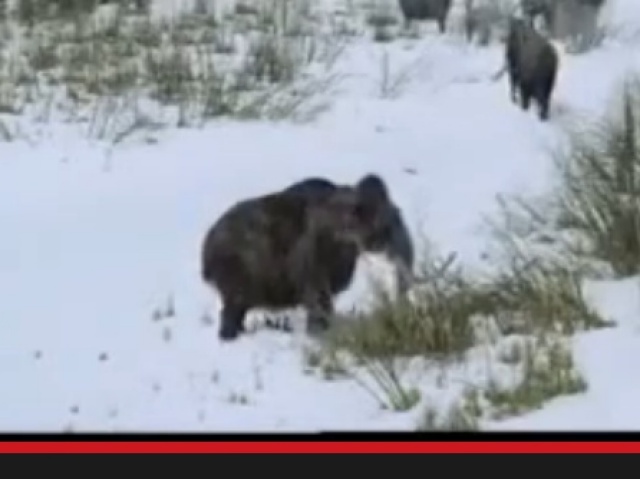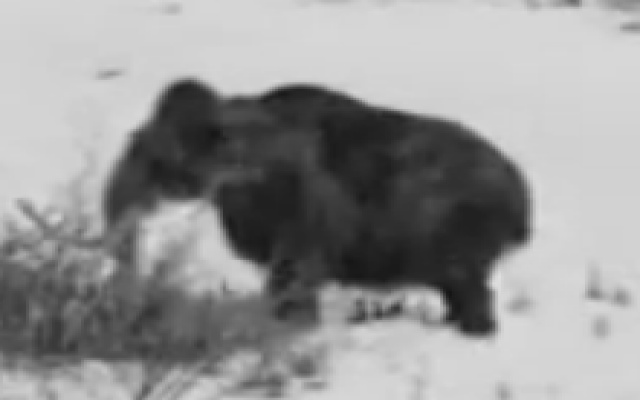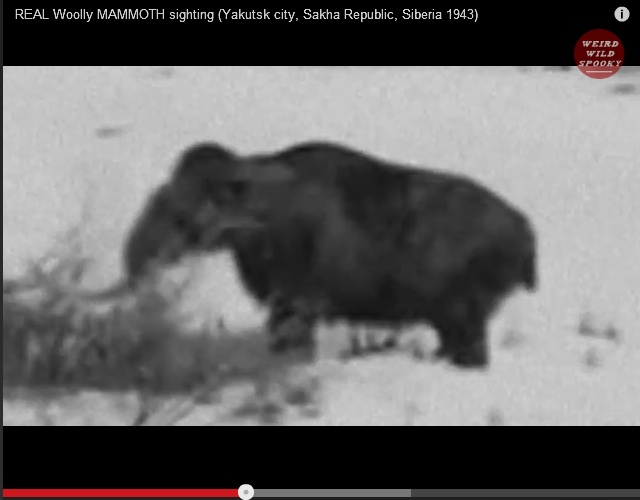It looks like you're using an Ad Blocker.
Please white-list or disable AboveTopSecret.com in your ad-blocking tool.
Thank you.
Some features of ATS will be disabled while you continue to use an ad-blocker.
share:
You can skip to 19:02 in the above posted video and see the mammoth they zoomed in on, flipped the image, and changed to black and white. Good hoax
though, lol.
I don't know whether this is the real thing or not, but is there anyway that we work out the size of this so called Mammoth that is in the film?
Unless it is a baby mammoth, then I presumed that mammoths would be a great deal larger than an elephant. I may be wrong on this, but this was the
first thing that entered my head as I watched the film footage....
Just throwing this out as a thought... who's to say he took the footage?
i mean if you are marching they guys and you see a mamoth, you grab a acamera, could have easily been a Russian who filmed it on his cammera as they were shocked to see it in the wild...
just syaing its maybe not as clear cut as the Nzai filmed the Mammoth (if its real)
i mean if you are marching they guys and you see a mamoth, you grab a acamera, could have easily been a Russian who filmed it on his cammera as they were shocked to see it in the wild...
just syaing its maybe not as clear cut as the Nzai filmed the Mammoth (if its real)
Found a couple of facts about mammoths, they have always intrigued me since I was a boy reading books in the library.....
I was trying hard to look at the mammoths ear size in the film footage, due to the ears of a woolly mammoth being shorter than the modern elephant’s ears. Like their thick coat of fur, their shortened ears were an important cold-weather adaptation because it minimized frostbite and heat loss...
Even a kid can discover a preserved mammoth. In September 2012 in Russia, an 11-year-old boy named Yevgeny “Zhenya” Salinder happened upon an extremely well-preserved woolly mammoth carcass while walking his dogs. The remains were of a 16-year-old male woolly mammoth that died about 30,000 years ago. The discovery helped scientists conclude that the large “lumps” on a mammoth’s back were extra stores of fat to help it survive winters. The mammoth was nicknamed “Zhenya.”....
The final resting place of woolly mammoths was Wrangel Island in the Arctic. Although, most of the woolly mammoth population died out by 10,000 years ago, a small population of 500-1000 woolly mammoths lived on Wrangel Island until 1650 BC. That’s only about 4,000 years ago! For context, Egyptian pharaohs were midway through their empire and it was about 1000 years after the Giza pyramids were built. The reason for the demise of these woolly mammoths are unknown...
Contrary to common belief, the woolly mammoth was hardly mammoth in size. They were roughly about the size of modern African elephants. A male woolly mammoth’s shoulder height was 9 to 11 feet tall and weighed around 6 tons. Its cousin the Steppe mammoth (M. trogontherii) was perhaps the largest one in the family — growing up to 13 to 15 feet tall...I thought they were much bigger than a modern day elephant..........
The woolly mammoth was not the only “woolly” type of animal. The woolly rhinoceros, also known as the Coelodonta, co-existed with the woolly mammoth, walking the Earth during the Pleistocene epoch. Like the woolly mammoth, the woolly rhino adapted to the cold with a furry coat, was depicted by human ancestors in cave paintings and became extinct around the same time...
Cave paintings drawn by ice age humans show the important relationship they had with the woolly mammoths. The Rouffignac cave in France has 158 depictions of mammoths, making up about 70% of the represented animals that date back to the Upper Paleolithic period. There is also evidence of the use of bones and tusks by humans to create portable art objects, shelters, tools, furniture and even burials...
Today, the hunt is on for woolly mammoth tusks in the Arctic Siberia. Due to global warming, the melting permafrost has begun revealing these hidden ivory treasures for a group of local tusk-hunters to find and sell. A tusk can range from 10-13 foot in length and a top-grade mammoth tusk is worth around $400 per pound. Mammoth ivory, unlike elephant ivory, is legal...
The first fully documented woolly mammoth skeleton was discovered in 1799. It was brought to the Zoological Museum of the Zoological Institute of the Russian Academy of Science in 1806 where Wilhelm Gottlieb Tilesius put the pieces together. Basing his task off of an Indian elephant skeleton, Tilesius was successful in reconstructing the first skeleton of an extinct animal except for one error. He put the tusks in the wrong sockets, so that they curved outward instead of inward...
The coat of a woolly mammoth consisted of a “guard” of foot long hairs, and an undercoat of shorter hairs. Preserved mammoth hair looks orange in color, however researchers believe the pigment was changed because of prolonged burial in the ground...
Interesting stuff even if the mammoth is a hoax or not in the film footage........
I was trying hard to look at the mammoths ear size in the film footage, due to the ears of a woolly mammoth being shorter than the modern elephant’s ears. Like their thick coat of fur, their shortened ears were an important cold-weather adaptation because it minimized frostbite and heat loss...
Even a kid can discover a preserved mammoth. In September 2012 in Russia, an 11-year-old boy named Yevgeny “Zhenya” Salinder happened upon an extremely well-preserved woolly mammoth carcass while walking his dogs. The remains were of a 16-year-old male woolly mammoth that died about 30,000 years ago. The discovery helped scientists conclude that the large “lumps” on a mammoth’s back were extra stores of fat to help it survive winters. The mammoth was nicknamed “Zhenya.”....
The final resting place of woolly mammoths was Wrangel Island in the Arctic. Although, most of the woolly mammoth population died out by 10,000 years ago, a small population of 500-1000 woolly mammoths lived on Wrangel Island until 1650 BC. That’s only about 4,000 years ago! For context, Egyptian pharaohs were midway through their empire and it was about 1000 years after the Giza pyramids were built. The reason for the demise of these woolly mammoths are unknown...
Contrary to common belief, the woolly mammoth was hardly mammoth in size. They were roughly about the size of modern African elephants. A male woolly mammoth’s shoulder height was 9 to 11 feet tall and weighed around 6 tons. Its cousin the Steppe mammoth (M. trogontherii) was perhaps the largest one in the family — growing up to 13 to 15 feet tall...I thought they were much bigger than a modern day elephant..........
The woolly mammoth was not the only “woolly” type of animal. The woolly rhinoceros, also known as the Coelodonta, co-existed with the woolly mammoth, walking the Earth during the Pleistocene epoch. Like the woolly mammoth, the woolly rhino adapted to the cold with a furry coat, was depicted by human ancestors in cave paintings and became extinct around the same time...
Cave paintings drawn by ice age humans show the important relationship they had with the woolly mammoths. The Rouffignac cave in France has 158 depictions of mammoths, making up about 70% of the represented animals that date back to the Upper Paleolithic period. There is also evidence of the use of bones and tusks by humans to create portable art objects, shelters, tools, furniture and even burials...
Today, the hunt is on for woolly mammoth tusks in the Arctic Siberia. Due to global warming, the melting permafrost has begun revealing these hidden ivory treasures for a group of local tusk-hunters to find and sell. A tusk can range from 10-13 foot in length and a top-grade mammoth tusk is worth around $400 per pound. Mammoth ivory, unlike elephant ivory, is legal...
The first fully documented woolly mammoth skeleton was discovered in 1799. It was brought to the Zoological Museum of the Zoological Institute of the Russian Academy of Science in 1806 where Wilhelm Gottlieb Tilesius put the pieces together. Basing his task off of an Indian elephant skeleton, Tilesius was successful in reconstructing the first skeleton of an extinct animal except for one error. He put the tusks in the wrong sockets, so that they curved outward instead of inward...
The coat of a woolly mammoth consisted of a “guard” of foot long hairs, and an undercoat of shorter hairs. Preserved mammoth hair looks orange in color, however researchers believe the pigment was changed because of prolonged burial in the ground...
Interesting stuff even if the mammoth is a hoax or not in the film footage........
reply to post by 2ndFUTURE
yup i agree, vegetation movement etc line up exaction when i reverse the images
yup i agree, vegetation movement etc line up exaction when i reverse the images
reply to post by ZeussusZ
I'm no expert, but I don't believe that is wind blowing it's hair. I think its doing the shudder thing, like dogs do when you itch the right spot.
Interesting video!
I'm no expert, but I don't believe that is wind blowing it's hair. I think its doing the shudder thing, like dogs do when you itch the right spot.
Interesting video!
Originally posted by 2ndFUTURE
You can skip to 19:02 in the above posted video and see the mammoth they zoomed in on, flipped the image, and changed to black and white. Good hoax though, lol.
I have yet to put forth the effort to line the two video clips up side by side and play them to see if they match up in every little detail, but I did watch from 19:02 and I hate to say it, but I think you're right. Damn. Had my hopes up! Nice catch, 2ndFUTURE. You have a good eye.
I went back and checked and even the vegetation matches up. I hate hoaxers! Blah! I wanted it to be a mammoth!
edit on 9/5/2013 by gemineye
because: (no reason given)
reply to post by RUFFREADY
one of the few videos I wish were real.
suddenly i'm in the mood for a bronto-burger.
Yabba dabba doo
one of the few videos I wish were real.
suddenly i'm in the mood for a bronto-burger.
Yabba dabba doo
Originally posted by 2ndFUTURE
You can skip to 19:02 in the above posted video and see the mammoth they zoomed in on, flipped the image, and changed to black and white. Good hoax though, lol.
The documentary, zoomed in a bit...

The documentary, zoomed in a bit more, cropped, grey scale and mirrored...

And now compare that with the supposed 1940's film...

Time to move this to the HOAX bin.
reply to post by 2ndFUTURE
Jeez that sucks. Tricked me! Good effort on wading through the whole show and spotting that! Still I wouldn't be totally shocked if a mammoth was found alive somewhere.
Jeez that sucks. Tricked me! Good effort on wading through the whole show and spotting that! Still I wouldn't be totally shocked if a mammoth was found alive somewhere.
Dayum another one bites the dust and heads for the HOAX bin.
In ya go.
In ya go.
reply to post by RUFFREADY
Wow.. That looks very real to me.
It can ofcourse be fake. What can not, nowadays?
There's plenty of DNA of mammoths too..
Frozen Mammoth found
Wow.. That looks very real to me.
It can ofcourse be fake. What can not, nowadays?
There's plenty of DNA of mammoths too..
Frozen Mammoth found
Who knows man. Its not that much of a stretch that there could be furry elephants up north somewhere
What a nice crisp picture for 1943, I didn't know they had HD cameras back then. All joking aside I think the channels disclaimer has proved this one
a fake, so my job is done here.
reply to post by alfa1
Very good.
I don't think they cropped it enough though. I caught a glimpse of the rear foot of the wooly that can be seen going up the hill in the documentary.
Very good.
I don't think they cropped it enough though. I caught a glimpse of the rear foot of the wooly that can be seen going up the hill in the documentary.
Oh my god. You lot are so GULLIBLE ! The level headed on here were laughing themselves something stupid at some of your replies. A live woolly mammoth
Some of you will believe ANYTHING
Well, if someone wants to find if there were mammoths around in an area in the forties, a good place to start would to look at some materials from the
forties that could have been with the hides in the backwoods of Russia. Seems to me that the old people didn't waste much, they would utilized the
hides. Maybe a door hanging in an old house or something, people knew how to tan hides for a long time. I'm sure the bones would have been chopped
up and made into soup. I know if there were mammoths around here, people would be secretly eating it and science would never find out. There would
probably be big fines for killing a mammoth IF you got CAUGHT .... Shhh...
new topics
top topics
-
Federal law trumps state and local law every time
Social Issues and Civil Unrest: 14 hours ago, 17 flags
active topics
-
Both KAMALA and OBAMA are on the Nov 5th 2024 Ballot - If One Loses - Both Lose.
2024 Elections • 8 • : WeMustCare -
DOJ Special Counsel Robert HUR Says JOE BIDEN Can Be ARRESTED After Jan 20th 2025.
Above Politics • 27 • : ADVISOR -
-@TH3WH17ERABB17- -Q- ---TIME TO SHOW THE WORLD--- -Part- --44--
Dissecting Disinformation • 3383 • : 777Vader -
How many people, in GENERAL, are musically inclined?
Music • 26 • : Huronyx -
Well, here we go red lines crossed Biden gives the go ahead to use long range missiles
World War Three • 395 • : annonentity -
Federal law trumps state and local law every time
Social Issues and Civil Unrest • 30 • : ADVISOR -
Elon Says It’s ‘Likely’ He Buys Tanking MSNBC
Political Ideology • 81 • : WeMustCare -
I thought Trump was the existential threat?
World War Three • 79 • : visitedbythem -
Joe Biden Dabs Away Tears at Farewell White House Dinner
Politicians & People • 25 • : RazorV66 -
A Mysterious Orb filmed over NYC by local news
Aliens and UFOs • 26 • : DaydreamerX
